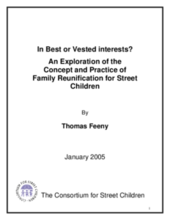As the movement advocating children’s participation in their own life decisions gathered pace in the late 1990s and early 21st century, governments were left with increasingly few options given their continued antipathy to the presence of these children on the streets. NGOs had begun to take the initiative by offering non-formal education opportunities and vocational training to try and give children the skills to get themselves off the streets, but these efforts continued to struggle in the wider context of a society still very much averse to the mere existence of these children.
The response taken by many was therefore to move towards preventive or ‘early’ intervention, spurred on by better understandings of the multiple factors both pushing and pulling children onto the streets. It was into this arena that family reunification programmes emerged – the main characteristics being (a) recognition of the family as the most sustainable partner with regard to the children’s welfare; (b) an acknowledgement that the original causes of family separation need addressing and resolving; and (b) a belief that this can be achieved through procedural and participatory counseling of the child and/or the family members concerned. To suggest that these ideas were completely new would be wrong – as noted earlier, the importance of the family environment had already been emphasised in both religious ideals and the legal provisions of the CRC. Rather, it was that the context proved more fertile to such programmes, with the touted high-profile success of reunification strategies targeting children affected by war, such as Rwanda in the late 1990s. Family-partnered interventions were also in tune with contemporary donor demands for sustainability and participation, while also allowing NGOs to claim such programmes as morally and ethically ‘correct’ and in the ‘best interests’ of the child. Unfortunately, the most important question of methodology – how this reunification process should best be performed – remains unclear.
Whatever the motivation behind them, family reunification programmes are now rapidly taking off in many countries around the world, in spite of the inherent methodological uncertainty. Already, organisations have begun to proudly proclaim 80-90% success rates for their reunification programmes, and more and more of their fellow agencies are showing signs of interest.
This study sets out to go ‘behind the scenes’ of family reunification programmes from a number of perspectives. In Part One, it will look at the conceptual theory that underpins this intervention, and examine how constructions of the ‘family’ and the ‘child’ have influenced policy making in this field. It will then reconsider these in light of contemporary research material on the social realities of street children’s lives. Part Two will then explore the practical issues relating to the entire process of reunification itself, from the early stages of identifying children on the streets to monitoring their welfare in the weeks and months after reunification with their family. A final Conclusion will then discuss the findings of the study and its implications for organisations operating or considering starting family reunification programmes with street children. Areas for future research are also highlighted.
©The Consortium for Street Children

